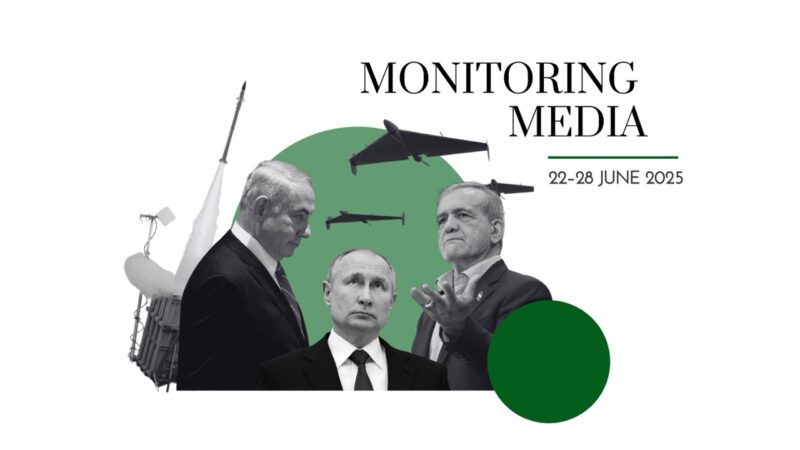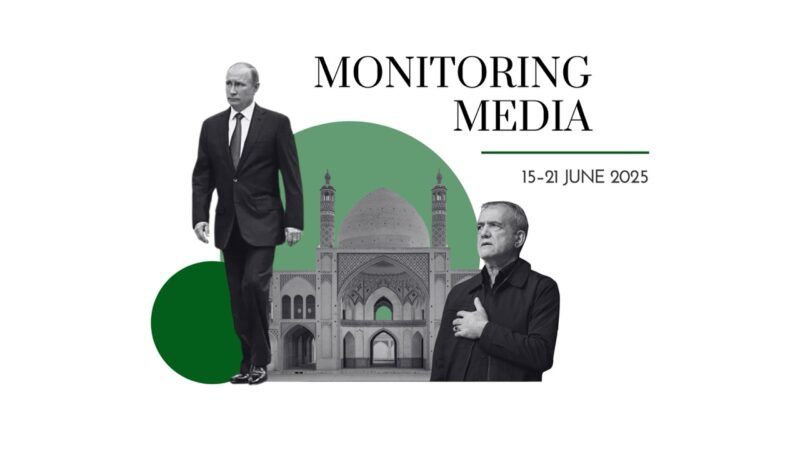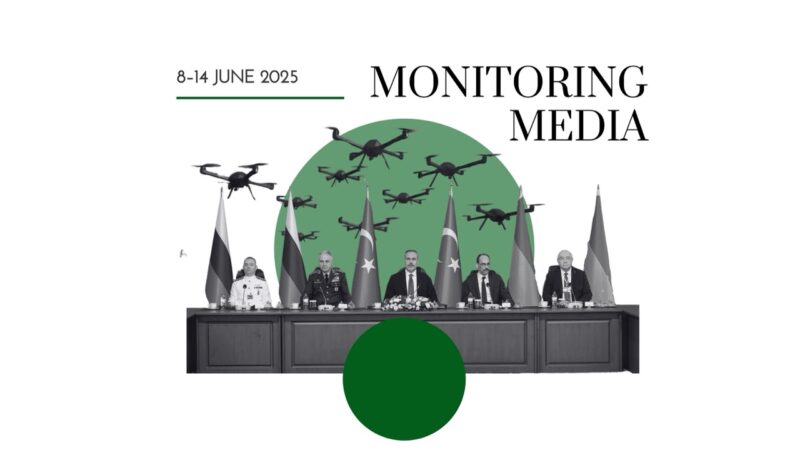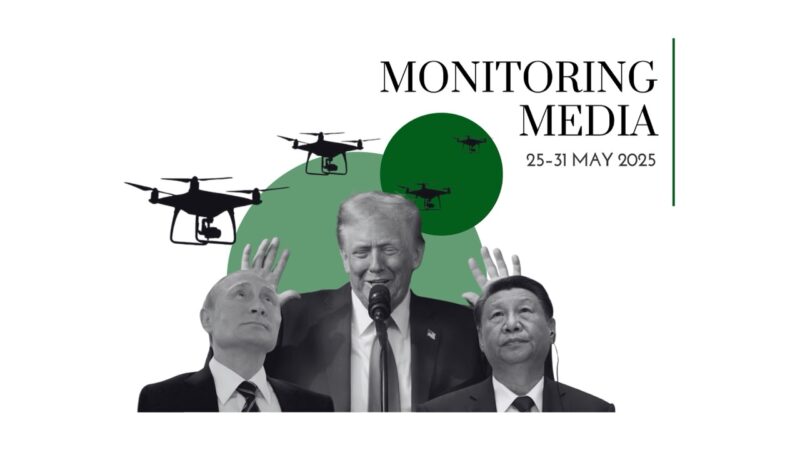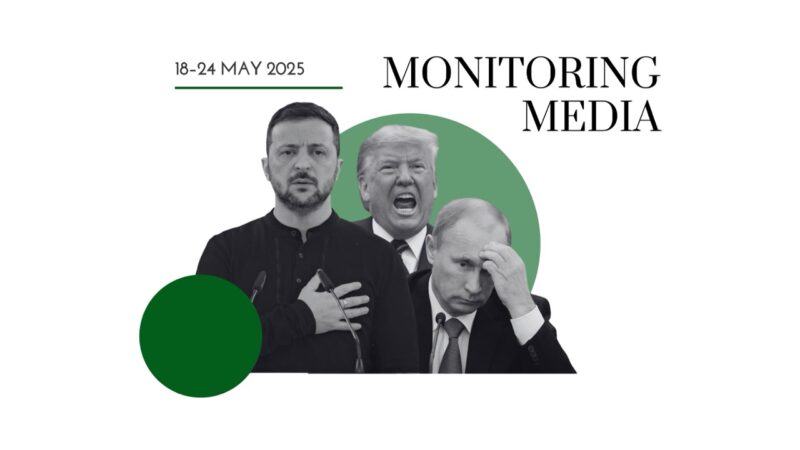One year of Russia’s full-scale invasion of Ukraine: CIUS Media Monitoring Service reports
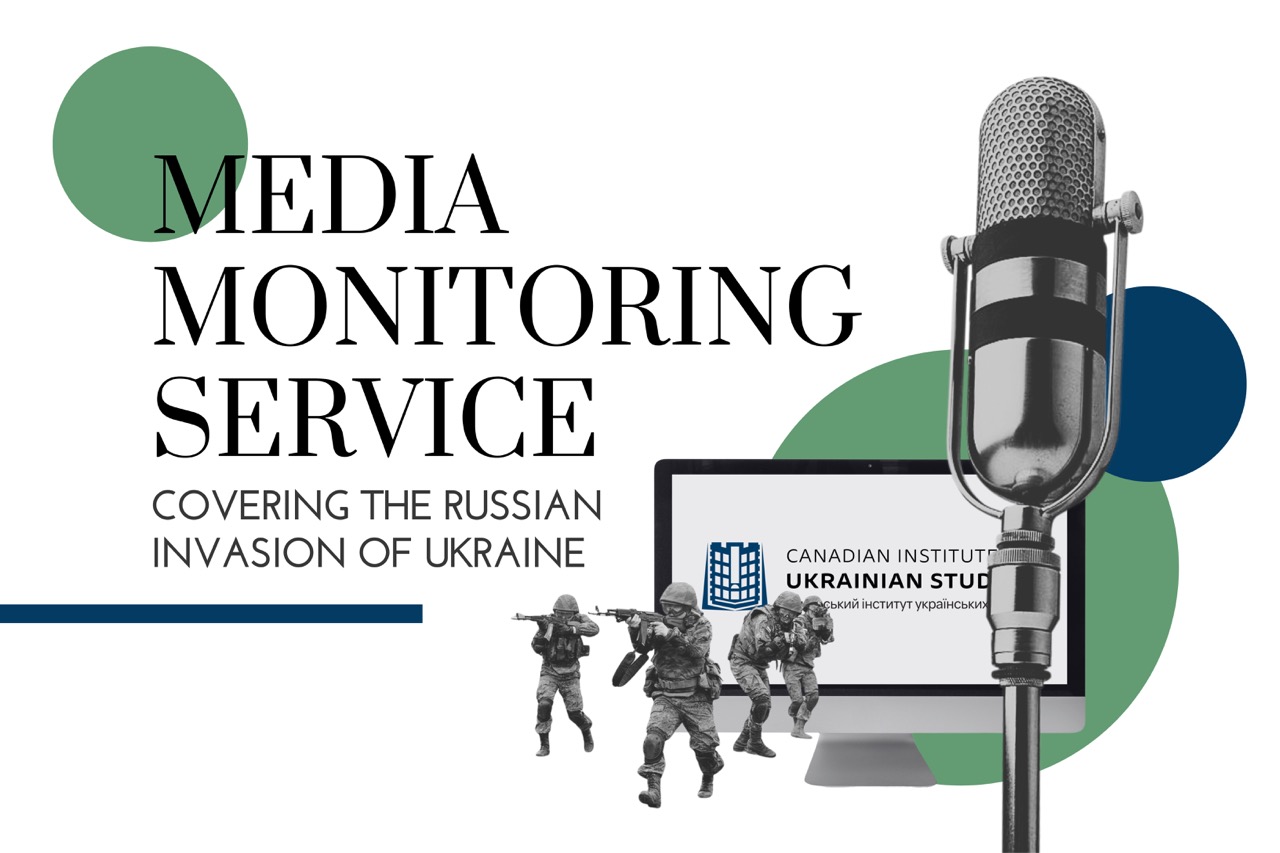
In an interview marking the first year of Russia’s full-scale invasion of Ukraine, the CIUS Media Monitoring Service team reflects on how the media has evolved and the challenges it faces when reporting about Ukraine. MMS team members also share their plans for the future of the project at the University of Alberta as it continues to produce weekly analysis on Ukraine-related reportage in the media.
The transcript of the roundtable was edited for clarity.
CIUS Director Natalia Khanenko-Friesen: On 24 February 2023 the world marks one year since the Russian Federation escalated its invasion of Ukraine.
There is more than one front where this war has been fought, with many recognizing the importance of the informational front. The Russian Federation has engaged in an information war with Ukraine and the world since before it attacked Ukraine in 2014. Careful examination and deconstruction of Russian propaganda and its false messaging is a key priority for our teams at CIUS and particularly for the Contemporary Ukraine Studies Program.
In March 2022, working intensively to respond to widespread demand for contextual perspective and quality analysis, CIUS launched its Media Monitoring Service under the CUSP aegis.
Dr. Oleksandr Pankieiev, editor-in-chief of CUSP’s online magazine Forum for Ukrainian Studies, heads the MMS project.
Dr. Ostap Kushnir surveys leading North American publications and writes the weekly analytical reports; an associate professor at Warsaw’s Lazarski University, he is a Kolasky Visiting Fellow at CIUS and in the Department of Political Science at the U of A.
Olena Goncharova, a journalist with the Kyiv Independent, surveys Canadian media for the MMS. These three analysts are respondents in the interview below.
The MMS team also includes CIUS’s Ksenia Maryniak, consulting copy-editor for the project as well as the entire Forum for Ukrainian Studies, and project assistant Kevin Theriault, an urban planning student at U of A and a senior volunteer for The Gateway, the university’s student journal.
Khanenko-Friesen: How did the MMS project start? What was the idea behind the project? What were its goals and what has been achieved?
Pankieiev: The need for proper analytical media monitoring has been emerging for years. Ukraine has been at the centre of the world’s attention at least since 2014, when Russia occupied Crimea and launched an armed intervention in the Donbas region of Ukraine. At that time, we noticed the lack of proper reporting on Ukraine.
If you look at how journalists, researchers, and all kinds of media covered events, they were doing it through the prism of Russia’s status, basing their interpretations on information coming from Russia, not Ukraine.
One of the reasons for this was that virtually since the establishment of the genre Ukraine has been perceived in the shadow of the “Russian studies” discipline, which has long dominated the intellectual discussions in academia and high offices in the West.
The problem, moreover, intensified when social media became the most ubiquitous way of disseminating information. Russia weaponized all available tools in order to shape the narratives and influence the public discourse that proved to be capable of influencing the trajectory of politics in democratic countries.
Thus, CIUS’s Media Monitoring Service aims to strengthen awareness about Ukraine from regional and global perspectives, while bringing attention to misinformation and misconceptions about it in North American analytical and popular media.
Our objective was to provide accurate information about Ukraine and call attention to reportage by agencies that still portray Ukraine from the perspective of Russia and even still use the same terminology that was employed in Soviet times.
Weekly as well as occasional MMS reports are published through the Forum for Ukrainian Studies, an open-access analytical magazine run by CUSP; the mandate of the MMS is to pinpoint misconceptions and misinformation and provide explanations where appropriate.
The MMS also serves as a resource for members of the Forum’s editorial board, helping them to shape strategy and identify experts as potential essay authors and interview subjects for items published on the Forum website ukrainian-studies.ca.
Russia’s colonial logic can be traced in many of the biases and misinformation being uncovered by the MMS. For instance, a widespread manipulation technique used by media outlets and unchallenged experts is to portray “Russia” as the biggest victim of World War II and the “defender of Europe from the Nazis.” One of the justifications used to support this claim is the number of “Russians” who died during that war. It has been stated repeatedly that “Russia” endured around 27 million casualties, but in reality it wasn’t “Russia”—it was the Soviet Union which comprised many subjugated nations. As a percentage of population, it’s Ukrainians and Belarusians who suffered the most casualties—significantly more than the Russians and more than the USSR average. Nevertheless, the Kremlin uses this narrative to try to justify its actions in Europe, Ukraine, and elsewhere and to rewrite history.
The MMS project also compiles a chronicle, systematically archiving its weekly coverage and detailed accounts of the main ideas put forward in news and analytical reports. Such an archive has the potential to become a valuable aid for future scholars, to study what events happened and how the perceptions of those events and of Ukraine in general have evolved.
The materials collected and analyzed in our reports can also be studied as an intellectual history of many ideas about international relations that have dominated not only since the end of the Cold War and the collapse of the Soviet Union but even since the end of the Second World War, as well as the role of Ukraine in changing many of those concepts and beliefs.
Khanenko-Friesen: How has the portrayal of the Russo-Ukrainian war changed in North American media since 24 February 2022?
Pankieiev: There is still room for improvement. But we can say that we have witnessed a dramatic change in the positionality of Ukraine. Ukraine is finally regarded as a rightful actor in the international arena and not an object of the affairs and interests of others.
For instance, discussions of Russia’s (false) narratives about the presumed justifications and concerns that were used to launch the full-scale invasion of Ukraine were dropped as being unreasonable and absurd. On the other hand, the agenda is now formed based on narratives of support for Ukraine’s rights to self-determination and protection of its territorial integrity according to the norms of international law.
Yes, there still are pundits and officials who promote pro-Russian narratives. But it has become more difficult for them to do so now because the world has learned more about Ukraine and sees the factual inconsistencies in their interpretations and in news reports.
Khanenko-Friesen: What is the main accomplishment of the monitoring review of Canadian media, and how might it help local journalists who are covering Ukraine?
Goncharova: I feel like one of the main achievements is the fact that the reviews we produce are a collective effort that helps Ukraine to stay in the spotlight—namely, the political as well as humanitarian, academic, and media spotlight.
We track down popular news items, feature pieces, and opinion pieces, to ensure that we are monitoring not only the messaging that the journalists are using but also potential biases that might be included, keywords that we can see in the material, and even reactions to the stories. And yes indeed, I often read the comments to the stories I analyze, in order to understand whether a particular story has sparked interest or discussion.
I also try to track whether the Ukraine-related stories that we analyze for the MMS are trending on the respective websites at the time of the publication review, which unfortunately isn’t often the case. This alone can be seen as a signal for journalists to step up their publication efforts and perhaps include more stories with Ukraine interest content.
All together, what we have been doing here with Oleksandr and Ostap, I think, helps not only to promote Ukraine’s cause but also to highlight for domestic audiences here in North America how Ukraine has been fighting for its existence and how this fight has been portrayed in the media for the past year and more.
And I believe that these findings might help local journalists to understand which topics receive less coverage, to focus on explaining certain world developments in more detail. For instance, why the collective West, including Canada and the US, do still need to support Ukraine with heavy weapons and other types of aid—despite the price tag attached and the burden that taxpayers inevitably might feel.
In sum, I believe that this mission should continue—and the fact that we created what Oleksandr calls a “digital archive” of all those messages that we have seen since 24 February will be a tremendous help for academia as well as media here in Canada and the US.
Khanenko-Friesen: You analyze both French-language and English-language publications; is there much difference in the thematic areas/messaging that they have used in their Ukraine reporting over the past year?
Goncharova: It was very interesting for me personally, because I feel it’s very good that we have this French-language aspect in our reporting, and we have the chance to see what the most interesting topics are that French-language media in Canada have been reporting on.
I have to say, if we compare them to the English-language ones, they have been more or less the same in their coverage, which has included, of course, weapons procurement for Ukraine, Canada’s role in adhering to Western sanctions against Russia, the economic toll of Russia’s war—which has been a big burden for people not only in Ukraine but also in Europe and North America—and some geopolitical implications of the war.
However, I’d say that French-language media were trying to focus a little bit more on the humanitarian side of the war, and more often than not I encountered opinions and even feature stories that had this clear message of the fact that Canada needs to continue its support for Ukraine.
One really good example that comes to mind is something that perhaps more media should use once in a while when they cover the war in Ukraine: Despite the price shocks and pressure on Canadian households resulting from Russia’s war against Ukraine, it is still worth remembering that the inflation that we might feel here in the New World is just a tiny share of the burden taken on by the Ukrainian people on behalf of the Old World and democracies everywhere. I saw this message repeatedly in the French-language media that we have reviewed. And I think it is a very important issue to highlight, because a lot of people as the war is going on might not understand why we have to suffer all the hardships and why we should help a country that is thousands of kilometres away from Canada.
Khanenko-Friesen: What are the major Ukraine-related misconceptions that North American media outlets are susceptible to in their analyses?
Kushnir: First of all, one major misconception is that the Russo-Ukrainian war started on 24 February 2022. It did not! This particular war—the latest phase in Russia’s age-old genocidal intentions against Ukraine—started in 2014. Given that the UN regards acts of aggression as acts of war, Russia’s first warring action against Ukraine took place on 27 February 2014, or even earlier, when Russian soldiers with no insignia, in unmarked uniforms, appeared in Crimea. So, we have this war going on in Ukraine for eight years already.
A second misconception is that Russia has always been a superpower. No matter what has taken place on the battlefield, Russia is still believed to have additional resources, possessing sufficient materiél to continue fighting and eventually gaining victory. Moreover, if members of Western society and Western states would like to be present or interact with Central and East European states—not only Ukraine but Belarus, Poland, Moldova, and others—they subconsciously still need to “get approval” from the Kremlin. So Russia is considered to be a sort of supervisor for the region, a mediator if not manager for all relationships.
From this stems another misconception. Because the West has ventured to work directly with sovereign states in Central and Eastern Europe, Russia responded with aggression. Consequently, the sovereignty of Ukraine and of other CEE countries is downplayed by many North American media. These states are seen as incidentals between the West and Russia. So in a way, the misconception presents the reason Russia invaded, the reason why it started the war as being because the West had disregarded Russian interests in Central and Eastern Europe.
Indeed, not all media emphasize that when speaking of the CEE region, where Ukraine is the largest country, there should be no question as to the sovereignty of these states, their recognition by the UN, and their right to self-determination and to conduct their own independent foreign policy. If these states decide to democratize and integrate with Europe or with transatlantic institutions, it is their own affair and has no direct bearing on Russia or the Russian vision for the region.
Khanenko-Friesen: Which events and developments in the Russo-Ukrainian war were portrayed as pivotal by the North American media?
Kushnir: I would like to formulate my answer by clustering the topics. The first group or cluster of events highlighted by the Western media is Russia’s initial successes in invading Ukraine and the West’s responses to these successes. The second cluster is Ukraine’s successes and the West’s response to those successes. And the third cluster is the activity of Ukrainian society: mobilization, sacrifices, and the war effort.
In this light, at the beginning of Russia’s escalated invasion of Ukraine there was a predominant focus of the Western media on how fast Russia advanced and how much territory it conquered. Next, when the Russians had to withdraw from the northern part of Ukraine under pressure from Ukrainian defenders, the media wrote about how well the Ukrainian army performed. Then there was the Azovstal development and the Mariupol massacre, which were about the sacrifice and heroic deeds of ordinary Ukrainian civilians.
These three different clusters were highlighted in the media depending on the events transpiring in the war. In summer, for instance, when the Russians advanced in the Donbas and conquered Siverodonetsk and other cities, the Western media was reporting on the strength of the Russian army. When in September Ukrainians launched a counterattack and liberated the whole of Kharkiv oblast, the West began admiring how powerful the Ukrainians were. Then there was the explosion on the Kerch Bridge to Crimea, bombardment of airports in Crimea and in the Russian mainland. Whichever side has the momentary initiative, that is the side spotlighted by the media.
Khanenko-Friesen: How would you like to see the development of the project in the future?
Pankieiev: CIUS’s MMS project has proved to be really important for our audiences—and I’m deliberately using the plural because we have different audiences that we serve, that is, not only the general public but also policymakers and academia. Unquestionably, I know that the reports we produce for the MMS, as well as all the analytics available on the Forum for Ukrainian Studies, are really important to shape government policies in the West and how Ukraine is being regarded by the West. By surveying media narratives and providing expert interpretations CIUS serves as an invaluable information resource for those in responsible for policy setting and decision making, so that they are well informed on Ukraine’s position.
Furthermore, the scholarly reason is crucial because Ukraine is still mostly a “terra incognita” for the world. CIUS is focusing on all kinds of initiatives in order to change this situation, when Ukraine is portrayed just through the prism of Russia studies.
The analytical work being done particularly by CUSP, the Forum for Ukrainian Studies, and the MMS will help us to shape our scholarly offerings for general audiences and also for educational processes, as well as provide fundamental knowledge to support proper contextualization Ukrainian studies and decolonization of CEE, Soviet, and Russian studies.
Thus, beyond the present priority of providing information and critical analysis during wartime, it will be really important to continue the MMS as an analytical, policymaking, and scholarly resource afterward.
Kushnir: For me, the importance of this project resides in accumulating in one place all the narratives about Ukraine in general and about Ukraine during the war. The project started in March 2022, barely a month after Russia’s accelerated invasion. On a weekly basis we were studying what the Western media wrote about Ukraine, what specific narratives they highlighted, and what were the exact facts they used and arguments they operated with.
The year of media monitoring has produced a huge volume of data that not only allows us to track and trace the evolution of the Western portrayal of the events in Ukraine but also provides better insight in the discovery of Ukraine. Why did these events unfold? Why did Ukrainian civic society respond as it did? Why were Ukrainians successful on the battlefield despite all the predictions? So, I think that one of the major achievements of the project has been the accumulation of unique information about Ukraine and about the Russian invasion of Ukraine.
Goncharova: I believe that from a journalist’s perspective we are doing a really indispensable job, because we are collecting information and highlighting potential issues that perhaps deserve more attention from local media. Namely, once in a while to just have a story featuring a Ukrainian family is not enough to keep Ukraine in the spotlight, because at the end of the day that is our goal. Also, as a citizen of Ukraine I feel that we need major efforts by numerous collectives to help our country to win the war.
And unfortunately, war fatigue is a real thing. That is why trying to track new angles to look at, different developments within Ukraine, not only war-related but also economy-related or academic, is incredibly important for the media not only here in North America but in Ukraine as well. I believe that even for journalists in Ukraine knowing that we have this incredible database of materials might be of tremendous help.
CIUS and the Media Monitoring Service team acknowledge the supporters and community partners without which its valuable work would not be possible: the Alberta Society for the Advancement of Ukrainian Studies, the Petro Jacyk Education Foundation, and the Alberta Local and International Education Association.
